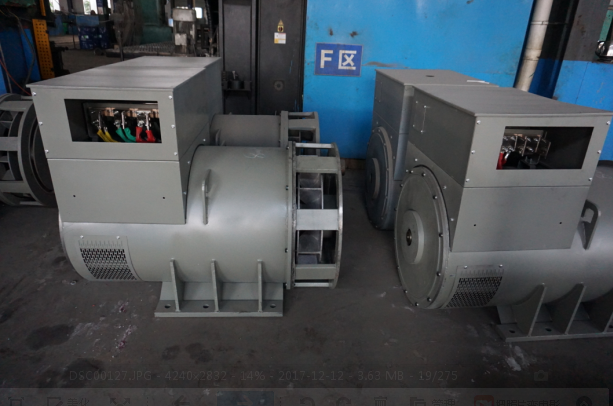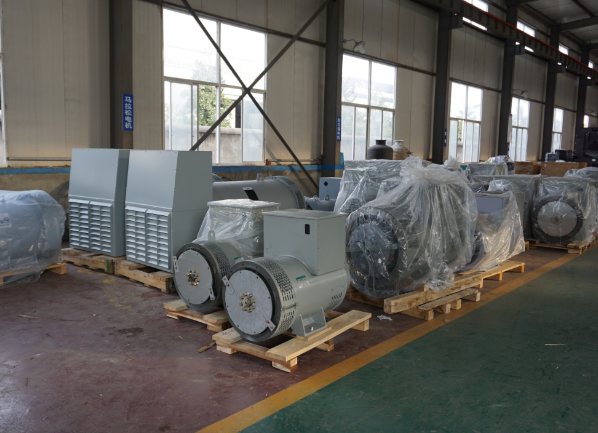The generator should be installed in a clean environment, well ventilated and easy to inspect and manage. There should be no water vapor, oil mist or other harmful gases near the generator, and there should be no hindrance in the inlet and outlet of the generator to keep the air flow unimpeded. Note that the nearby heat source will not affect the cooling of the generator. If the engine is driven by an internal combustion engine, attention should be paid to the layout of the engine room so that the exhaust and heating parts of the internal combustion engine will affect the inlet air temperature of the generator to the lowest extent. Outdoor use should pay special attention to prevent Rain Water, moisture and dust, sand and other immersion inside the generator. An anti-condensing heater (or moisture-proof heating belt) can be added in the environment where the air humidity is high and condensation is easy to occur. When the generator is not in operation, the heater is connected, so that the temperature of the generator's fuselage is higher than the ambient temperature. The heater must be cut off while running. Air filters should be installed in places where there is more wind or dust.

The generator must be kept level during installation. The installation of generators is very important and will affect the life of generators, so the installers and the parts of equipment used in generators need to be approved.
The prime mover and generator shall be mounted on a common underframe of sufficient strength to avoid collapse or deformation. It is recommended that 8.8 grade strength bolts should be used. When tightening installation bolts, it is necessary to ensure that the bottom pad of the generator is solid and the machine seat does not deform. When installing, the bearing of the generator must not be subjected to axial thrust. The rolling bearing of the generator is not designed to bear the axial thrust caused by the installation. Note that the connecting flange of the generator cannot bear too much prime mover weight when the front bracket is the only one, and the intermediate support should be added if necessary.

Check the hoists (cables, hooks, etc.) before lifting the generator, and confirm the method of lifting and the capacity of the crane. Installation should use hoists, double hooks to lift the generator before and after the climb, slow and steady lifting. Steel cable contact generator should cushion soft to prevent damage to the generator surface.
The generator cannot be hoisted with a single hook, nor can it be hoisted from the generator. When lifting a single bearing generator, care must be taken to keep the generator seat level. When transporting a single bearing generator, the transmission plate is fixed by bolts and connecting flanges.
The generator and the prime mover shall be straight and coaxial. Single bearing generators are provided with connecting flanges and disk couplings (flexible drive plates) conforming to SAE standards for easy connection with the flywheel housing and flywheel of the prime mover. The double bearing generator is driven by coupling, and elastic coupling should be preferred. At this time, the concentricity and parallelism of the two half coupling should be measured carefully. High precision coaxial measurements are required for rigid coupling drives and a transition flange is recommended for mass assembly units. One end of the flange is docked with the end cover of the motor and the other end is docked with the prime mover, which greatly simplifies the installation. If you use other transmission methods, please contact the manufacturer.
Incorrect alignment between generator and prime motor may lead to serious equipment damage or personal accident. Single bearing generator ensures that the coaxial tolerance is within the allowable range by connecting with the inlet of the prime motor flywheel shell and flywheel. If a double bearing generator is not connected with a connecting flange, the coaxial tolerance of the prime mover and generator must be ensured to be less than 0.1mm.
Single bearing generators have flange stops and disk couplings (flexible transmission plates) that meet SAE standards for easy connection with the engine's flywheel housing and flywheel, and the assembly of the single bearing generator and the engine follows the following steps:
1. Check and confirm that the torsional vibration calculation of the generator meets the requirements
2. Check the SAE connection flange of the generator and the flywheel housing of the engine, the size of the SAE flexible transmission plate and the engine flywheel is consistent;
3. The front window cover plate of the motor is removed, and a suitable lifting method is adopted to position the generator and the engine, so that the flexible transmission plate of the generator is matched with the engine flywheel. The verticality and coaxiality of the connection surface between the flywheel and the flange shell generator should be adjusted and the control error should be within the 0.1mm (the metal thin gasket can be used between the generator foot and the underframe).
4. The flexible transmission plate and the connecting flange are fixed to the flywheel and flywheel shell of the engine with bolts respectively (the tightening torque should be fixed evenly and diagonally according to the specified tightening torque).
5. Install the front window cover of the motor and bolt the generator to the unit chassis.
The dual bearing generator is assembled by means of an elastic coupling and a connection between the connecting flange and the flywheel and flywheel housing of the prime mover, and no coupling and flange are provided when the dual bearing generator leaves the factory unless the contract requires, The assembly of dual bearing generators and engines follows the following steps:
1. Install elastic couplings and connecting flanges for generators
2. And a suitable lifting method is adopted for butting the generator and the engine, so that the elastic coupling of the generator is matched with the flywheel of the engine, and the coupling flange is matched with the flywheel shell of the engine.
3. Check the concentricity of the engine and the generator to ensure that the coaxiality tolerance is 0.01mm, and the position of the two shafts in the axial and radial direction can be corrected with a dial indicator and a thin metal gasket.
4. Bolt the connecting flange to the flywheel housing of the engine (fasten evenly at the angle of the specified tightening torque).
5. Bolt the generator to the underframe of the genset.
Turn
The direction of rotation of the generator shall conform to the direction indicated by the direction sign on the generator. If the direction of rotation is opposite, the phase sequence of the generator output voltage will also be reversed.
Wiring
According to the voltage requirements, according to the wiring diagram to select the appropriate wiring mode, the correct connection between the motor and the output line should be in accordance with the diagram to tighten the end of the screw nut.
Grounding, protection
The neutral line of the generator is not connected to the generator base when the generator is in the factory. There is a ground terminal near the main terminal in the outlet box. If the neutral line is to be grounded at the time of operation, the user needs to connect the neutral terminal and the ground terminal with one conductor whose cross-section is half of the lead cable. The overspeed of the prime motor, the over-pressure of the generator and the over-flow will result in the damage of the equipment. The unit shall have reliable overspeed, over-pressure, over-flow, short-circuit and other protection devices. The parallel unit shall also have the inverse power protection.
The generator should be installed in accordance with the local power department regulations and safety regulations, installed electrical protection device to ensure the correct grounding (in the outlet box and on the foot of the grounding bolt).
Copyright © Guangxi Dingbo Generator Set Manufacturing Co., Ltd. All Rights Reserved | Sitemap
Update cookies preferences